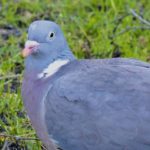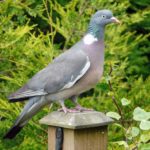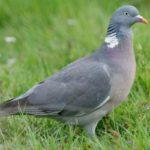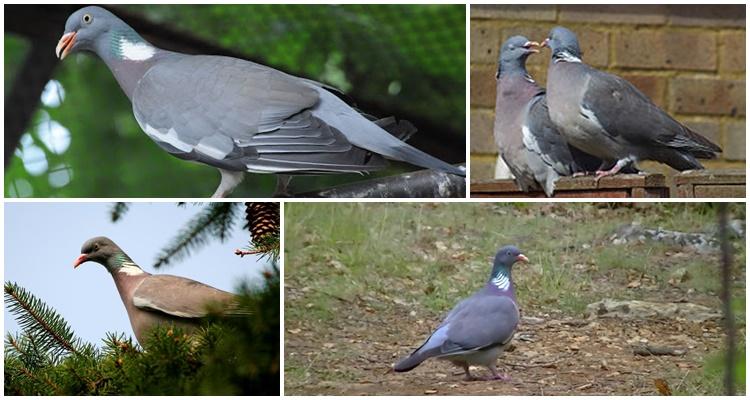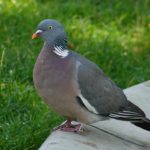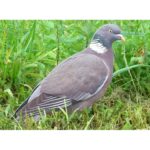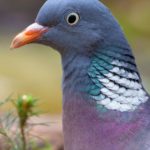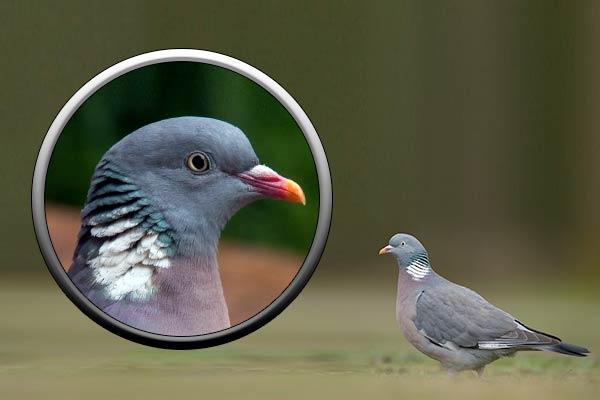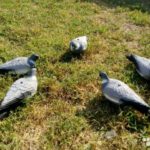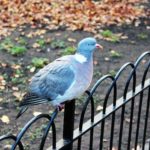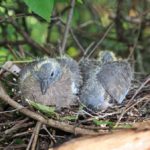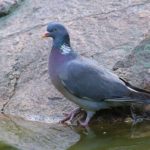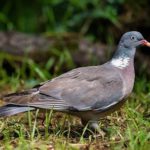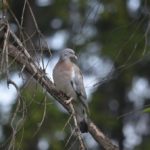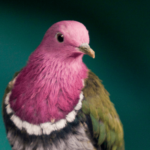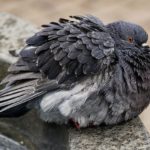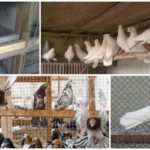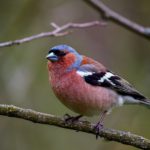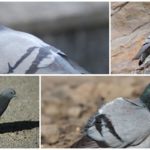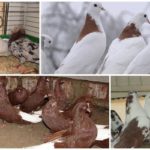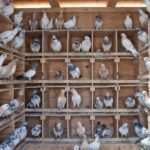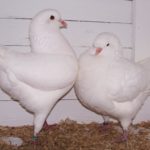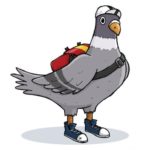“Vityuten” or “pigeon” are the names of the same species of pigeons that live in the forest belt. The bird attracts attention with its unusual size for a pigeon breed. The wood pigeon is much larger than its relatives, but in other external characteristics it is almost no different from urban or domesticated pigeons of other breeds. The color of the feathers, which is characterized as calm and rich, allows the bird to hide among the trees from predators.
- Origin of the species and description of the bird
- Varieties of wood pigeons
- Habitat
- Diet
- Territory and habitat
- Character and lifestyle
- Social structure and reproduction
- How do pigeon pairs form?
- Arrangement of the nest
- Hatching eggs
- Care of offspring
- Natural enemies of the wood pigeon
- Population and species status
Origin of the species and description of the bird
Species of wild forest pigeons Begins its history from the times of Ancient Greece. Historians note that the descriptions contain references to wild birds that in appearance resemble wood pigeons. The species has existed for many centuries without visible changes. Characteristics of the wood pigeon's external data:
- Feather coloring. The main color background is blue-gray; among the tail feathers there are brighter feathers; on the chest there are small splashes of reddish and green tints.
- Weight and dimensions. The maximum weight for birds of this species is 1 kilogram. The body is oblong, elongated, reaching 50 centimeters in length. The head is proportional to the body, smoothly blending into the body.
- Wings and paws. When the wing opens, its span reaches 80 centimeters. The wingspan allows it to reach speeds of up to 180 kilometers per hour. The feet are pink-red, with sharp claws that help the bird to anchor itself on the bark of trees.
Reference! The average lifespan of wood pigeons is 10-16 years.
Varieties of wood pigeons
There are up to 35 species in the genus of wood pigeons; they are distinguished by habitat and external differences.
| View | Description |
| Azores | The color is darker, found in the Azores archipelago |
| Iranian | Features lighter colored plumage |
| Asiatic | Has narrow yellowish spots on the neck |
| North African | Lives in northern Africa, has no external differences |
| Gigi | Found in Sardinia |
The main species have several dozen subspecies. The total number of varieties reaches 290 copies.
Habitat
The wood pigeon lives in Europe, settles in Western Siberia, and is found in Africa.The pigeon belongs to the category of migratory or partially migratory birds. The sedentism of a pigeon is determined by its sensitivity to temperature conditions.
Diet
The basis of the pigeon's diet is plant food. Pigeons feed on berries, young tree buds, seeds and grass. They often find seeds and remains of cereal crops in areas that separate forests from fields and meadows. If it is impossible to obtain their usual food, pigeons are able to feed on clover leaves and cabbage. This indicates the high adaptive qualities of the species and the ability to survive in different conditions.
Reference! Wood pigeons store food for some time, using physiological capabilities. The bird's crop holds up to 8 acorns.
In some cases, the wood pigeon feeds on worms and insects. This happens at the transitions of the seasons, when it is difficult to obtain plant food, and strength is necessary for survival.
Territory and habitat
The habitat for the wood pigeon can be different. Birds live in dense coniferous forests, in the territory of mixed deciduous and coniferous zones. They adapt to the conditions of existence. Birds are often found where they have the opportunity to obtain acorns for food and build nests away from places where they can be hunted by humans.
Character and lifestyle
Wood pigeons are often recognized by their voice. Its vocal characteristics are different from those of the pigeon breed of related species. These are characteristic loud sounds that fill the forest from early morning. Wood pigeons are silent only during the breeding season, when mating occurs.
In general, birds constantly show caution, they are attentive to the sounds of the forest, and quickly leave their homes when danger approaches. Pigeons are calm and do not start fights among themselves. Most often they keep in pairs, but at the same time they gather in numerous flocks in the fall, when the majority of birds give birth to offspring. Pigeons are very sociable among themselves; they are energetic and sociable birds that are constantly looking for the best place to build nests.
Wood pigeons are distinguished by the heterogeneous nature of their migration. A group of southern pigeons leaves for the winter in warm countries with the approach of cold weather, but they are replaced by northern birds that occupy their previously occupied places. Flight times vary every year. Birds begin moving in September and finish in a month. As the weather warms up, the birds gradually move away and begin their return flight.
When migrating, birds move during the day; at night they find shelter and hide among the foliage of tall trees. The pigeons make their way back along the same route, stopping in the same places. When they fly for the winter, the flight is characterized by swiftness; they rarely stop to rest during the day. After wintering, the flight takes longer. Each time a stop occurs, the pigeons scatter in search of food, fill their crops, and leisurely stroll among the fields or meadows they find with food.
Social structure and reproduction
In one season, females are able to give birth 3 times. The breeding process begins in April and lasts until October. Pigeons are called faithful birds, they become attached to each other and behave like a separate family within the flock.
How do pigeon pairs form?
Pigeons reach sexual maturity at 10-11 months.From this moment on, males actively attract females. They sit on the tops of trees and from early morning begin to attract attention with vocalizations. After the male realizes that he is interested in the female, he goes downstairs. The mating games continue for some time. They include the male circling the female and bilateral cooing.
Arrangement of the nest
Mating games end with the laying of eggs. But before this, pigeons organize space for further hatching of offspring. Pigeons carefully select materials for construction, use thick and thin branches, carefully weave branches into the frame, and build a durable floor. A special soft covering is provided for the poultry floor. The material for it is feathers from its own plumage, grass, and crushed young branches. Nests are located at a height of 2 meters. The structures are distinguished by strength, reliability and convenience. It is permissible to create gaps between the interweaves of rods: they are necessary for light and air to enter inside.
Reference! Wood pigeons never use the remains of nests of other breeds to build their own nest.
Hatching eggs
The female lays 2 eggs per laying. These are medium-sized white eggs. Both parents take an active part in hatching the offspring. They take turns warming the eggs with their warmth, and take turns getting food for each other. The incubation period of the chicks lasts 2 weeks. Researchers note that birds are in a state of heightened attention all the time. When one pigeon is resting, warming the eggs, the other guards the nest and regularly flies around the area, looking out for enemies.
Care of offspring
The hatched chicks feed on bird milk.It is a curd-like residue that accumulates in the female’s crop. Gradually the chicks are transferred to adult food. When the birds get stronger, parents begin to teach them the nuances of flight. By 1-1.5 months, the offspring are able to leave the nest and begin an independent life.
Natural enemies of the wood pigeon
Dangerous enemies of wood pigeons are birds of prey. They attack pigeons, destroy their nests, and eat their offspring. Falcons, hawks, and eagles look down on pigeons, so wood pigeons often hide in densely leafed trees. Pigeons become prey for jays, crows or magpies. These individuals act by cunning: they discover nests, wait, and attack only when the pigeon loses its vigilance.
Squirrels pose a danger to wood pigeons. They attack in trees and often win the fight. On the ground, if a bird lands to collect grains or cereals, martens, foxes, and badgers attack. Due to their impressive size, pigeons cannot instantly take off from the ground - this is a weakness in the bird’s defensive line of behavior. Pigeons settle 2 or more kilometers away from human habitation, since people are dangerous for this species. Wood pigeons are hunted for wild meat and also for capture due to their danger to oak trees.
Attention! The natural caution of wood pigeons is of interest to amateur hunters who track and shoot the bird.
Population and species status
Hunting for wood pigeons is not prohibited due to the fact that the birds are recognized as pests of agricultural land. Bird catching is considered one of the most exciting types of amateur hunting. Only one species of pigeon is under state protection - the Azores pigeon, which lives in the Azores archipelago.One of the subspecies of the Azores pigeon was completely destroyed.
The population is gradually declining, this happens for several reasons:
- catching or shooting by hunters;
- pest control due to the use of pesticides in fields intended for agricultural planting;
- an increase in the number of industrial zones that use harmful toxic substances released into the air.
Pigeons gradually move from their homes, explore new uncharted territories, where they die due to hunting by predators or die from natural causes.

